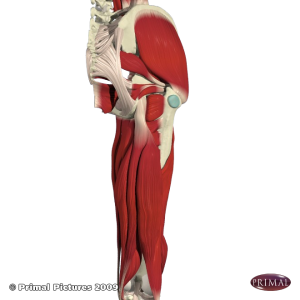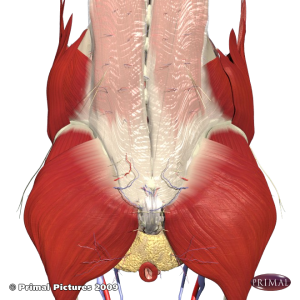Purpose: Info sheet for patients to learn why the SI joint can be a pain in the butt.
The sacroiliac joint (SI joint) occurs where the bottom of your spine meets your hip bones. You have two of them and they must bear all of the stress that goes from your upper body through your lower body and vice versa.
SI joint pain can be felt in the lower part of your back, into your buttock, down your thigh and even into the shin. People will often feel their leg give out and will feel a catch when walking. It is often confused with Sciatica. This pain can occur from simple picking up a pencil. Last pain in the area of the SI joint can even come from inches above the joint in the area called the T-L junction.
My chiropractor and physiotherapist tells me that this joint is out of alignment. While this might occur they certainly have no way of telling you. The joint itself only moves a couple of millimetres and only rotates a couple of degrees (if that). This is not something you can feel.
So why does it hurt? Good question…and simple the joint is irritated because somehow the joint is undergoing stress or load that it is not able to handle. This may be because of the idea that the joint is “stuck” and not moving properly or it can even be that the joint is moving improperly, is not supported by the muscles around the joint and is then irritated.
Mechanics of the joint: The sacrum is wedged into the pelvis but it still must move and bear a lot of stress. This puts it in the vulnerable position of having to be strong/stable but also mobile. To balance these two demands it gets stability from its architecture and inherent shape (e.g. the way the pieces fit together - Form closure) and also from all of the muscles that surround the joint and work to compress it to give it stability. This is called force closure.
 A loss of force closure - when the muscles around the joint do not do their job we end having a loss of force closure. This is a common finding in people with pain. What is amazing about the SI joint is the vast number of muscles that actually influence the joint. Muscles in the stomach, the deep stomach, the upper back, the hips, the back of the thighs, the front of the thighs and even the inside of the thighs all help stabilize the joint. A dysfunction in any of these muscles may end of causing SI joint pain. Take a look at how the muscles of the glutes cross over the SI joint in the picture at the top of this post. in the picture on the left note how the the hamstring muscles attach to a ligament that runs up to the joint. Amazing. Treatment to all these areas should certainly occur.
A loss of force closure - when the muscles around the joint do not do their job we end having a loss of force closure. This is a common finding in people with pain. What is amazing about the SI joint is the vast number of muscles that actually influence the joint. Muscles in the stomach, the deep stomach, the upper back, the hips, the back of the thighs, the front of the thighs and even the inside of the thighs all help stabilize the joint. A dysfunction in any of these muscles may end of causing SI joint pain. Take a look at how the muscles of the glutes cross over the SI joint in the picture at the top of this post. in the picture on the left note how the the hamstring muscles attach to a ligament that runs up to the joint. Amazing. Treatment to all these areas should certainly occur.
The rationale for treatment - A number of different treatments can help SI joint pain. Traditional chiropractic or physiotherapy manipulation can be amazing. A number of people will see an improvement immediately. This may be due to the joint being “stuck” after all or it can even be due to the manipulation influencing how the muscles work. Other treatment should look at evaluating all of the muscles that can influence the stability and movement of the SI joint. Massage or Active Release Technique (ART) can be used to release any tight, fibrotic or overworked muscles that may not be doing their job to provide joint stability. Typical physio modalities can also help with pain associated in these areas.
The importance of exercise - Most important are the exercises that you can do to help increase the strength of this joint…remember tissues, muscles and joints respond to stress. Strengthening or even “awakening” certain muscles around the SI joint can have a beneficial effect on this joint. In my opinion, exercises that target all of the muscles responsibility for stability are important to have a healthy and pain free spine.
Here is a sample exercise program. SI routine number 2
A caveat - The above description largely ignores our perceptions, beliefs and emotions. These can have a profound effect on the pain that one might feel in the SI joint. It is absolutely possible that there is no physical dysfunction related to your SI joint yet you are still experiencing pain from this area. Your SI joint can have a memory of pain that is “burned” into your brain. Treatment addressing this would of course be beneficial and should not be neglected.





kneepaintreatment.net…
The SI joint - a cause of low back pain « thebodymechanic.ca…